What Are More Efficient Transportation Services in a Rural Area? A Case Study in Yangsan City, South Korea
Abstract
:1. Introduction
2. Efforts to Improve Transportation Services in Rural Areas
2.1. Overseas Cases
2.2. Cases in South Korea
- Route passenger transportation business
- a.
- Intra-city bus transportation business.
- b.
- Rural and fishing bus transportation business: A passenger transportation business whose operation system is set in a single administrative district of mainly Gun (excluding Guns in metropolitan cities) using a vehicle prescribed by the Ordinance of the Ministry of Land, Infrastructure, and Transport. In such cases, its operation type is classified into intercity express bus, intra-city bus, and general bus as prescribed by the Ordinance of the Ministry of Land, Infrastructure, and Transport.
- Cases of transporting customers in areas where public means of transportation (hereinafter referred to as “public means of transportation”) such as route buses and trains (including city trains; hereinafter the same shall apply) are not operated or the access is extremely inconvenient;
- Cases of temporarily transporting customers in regions where the public means of transportation cannot be operated;
- Cases of no public means of transportation in the place of the facility or the access are extremely inconvenient.
2.2.1. Taxi Service: 9-Cent Taxi (Voucher Taxi)
2.2.2. Service Using a Small Bus: City-Type Bus
3. Is the City-Type Bus Running in Korea Operating Well as Planned?
3.1. Analysis of Operation Systems Using Digital Tachograph Data
3.2. Comparison between the Plan and Actual Operation Results
3.2.1. City-Type Bus No. 1 Route
3.2.2. City-Type Bus No. 2 Route
3.2.3. City-Type Bus No. 3 Route
3.2.4. City-Type Bus No. 4 Route
3.2.5. City-Type Bus No. 5 Route
3.2.6. City-Type Bus No. 6 Route
4. The Most Efficient Public Transport Method in Rural Areas
4.1. Operation Methods Using DRT Buses
4.2. Discussion: Selection of Operation Method Considering Regional and User Characteristics
5. Conclusions
Author Contributions
Funding
Institutional Review Board Statement
Informed Consent Statement
Data Availability Statement
Conflicts of Interest
References
- The Board of Audit and Inspection of Korea (BAI). Audit Report-Response to Demographic Change I (Region); The Board of Audit and Inspection of Korea (BAI): Seoul, Korea, 2021. [Google Scholar]
- Official Statistics of Finland (OSF). Population projection 2015 According to Age and Sex 2015–2065. In Whole Country; Official Statistics of Finland (OSF): Helsinki, Finland, 2015. [Google Scholar]
- Song, J. Present and tasks of balanced regional development through Japan’s regional revitalization policy. Korean J. Jpn. 2021, 126, 273–290. [Google Scholar] [CrossRef]
- Elshof, H.; Bailey, A. The role of responses to experiences of rural population decline in the social capital of families. J. Rural. Commun. Dev. 2015, 10, 72–93. [Google Scholar]
- Hoekstra, M.S.; Hochstenbach, C.; Bontje, M.A.; Musterd, S. Shrinkage and housing inequality: Policy responses to population decline and class change. J. Urban Aff. 2018, 42, 333–350. [Google Scholar] [CrossRef]
- Lindén, J.; Linna-Angelvuo, L.; Liinamaa, A.; Matinlassi, M.; Lehtiö, S.; Hassi, L.; Meritähti, L.; Koponen, V.; Saarinen, A. Asuntokannan ja Asuinolojen Kehittäminen Kasvukeskusten Ulkopuolella, Ympäristöministeriön Raportteja. 2017. Available online: https://julkaisut.valtioneuvosto.fi/bitstream/handle/10024/160268/YMra_23_2017.pdf (accessed on 11 June 2022).
- Kou, X.; Zhang, Y.; Long, D.; Liu, X.; Qie, L. An investigation of multimodal transport for last mile delivery in rural areas. Sustainability 2022, 14, 1291. [Google Scholar] [CrossRef]
- Vaishar, A.; Šťastná, M. Accessibility of services in rural areas: Southern Moravia case study. Sustainability 2021, 13, 9103. [Google Scholar] [CrossRef]
- Vasta, A.; Figueiredo, E.; Valente, S.; Vihinen, H.; Romero, M.N. Place-based policies for sustainability and rural development: The case of a Portuguese village “spun” in traditional linen. Soc. Sci. 2019, 8, 289. [Google Scholar] [CrossRef]
- Carbone, V.; Rouquet, A.; Roussat, C. The rise of crowd logistics: A new way to co-create logistics value. J. Bus. Logist. 2017, 38, 238–252. [Google Scholar] [CrossRef]
- Wang, Y.; Zhang, D.; Liu, Q.; Shen, F.; Lee, L.H. Towards enhancing the last-mile delivery: An effective crowd-tasking model with scalable solutions. Transp. Res. E 2016, 93, 279–293. [Google Scholar] [CrossRef]
- Mitrică, B.; Şerban, P.; Mocanu, I.; Grigorescu, I.; Damian, N.; Dumitraşcu, M. Social development and regional disparities in the rural areas of Romania: Focus on the social disadvantaged areas. Soc. Indic. Res. 2020, 152, 67–89. [Google Scholar] [CrossRef]
- Gollin, D.; Rogerson, R. Productivity, transport costs and subsistence agriculture. J. Dev. Econ. 2014, 107, 38–48. [Google Scholar] [CrossRef]
- Alder, S.; Roberts, M.; Bank, W. The effects of transport infrastructure on India’s. In Urban and Rural Development; World Bank Group: Washington, DC, USA, 2018. [Google Scholar]
- Akkoyunlu, Ş. The potential of rural-urban linkages for sustainable development and trade. Int. J. Sustain. Dev. World Policy 2015, 4, 20–40. [Google Scholar] [CrossRef]
- Starkey, P.; Hine, J. Poverty and Sustainable Transport-How Transport Affects Poor People with Policy Implications for Poverty Reduction: A Literature Review; UN-Habitat: Nairobi, Kenya, 2014. [Google Scholar]
- Hine, J.; Abedin, M.; Stevens, R.; Airey, T.; Tamala, A.M. Does the Extension of the Rural Road Network Have a Positive Impact on Poverty Reduction Resilience for the Rural Areas Served? If so How, and If Not Why Not? EPPI–Centre; Social Science Research Unit, Institute of Education, University of London: London, UK, 2016. [Google Scholar]
- Hine, J.; Sasidharan, M.; Torbaghan, M.E.; Burrow, M.; Usman, K. Evidence of the Impact of Rural Road Investment on Poverty Reduction and Economic Development; Institute of Development Studies: Brigton, UK, 2019. [Google Scholar]
- U.S. Department of Transportation. Rural Public Transportation Systems; United States Department of Transportation: Washington, DC, USA, 2019. [Google Scholar]
- American Public Transportation Association (APTA). Funding the Public Transportation Needs of an Aging Population; American Public Transportation Association (APTA): Washington, DC, USA, 2010; Available online: https://www.aarp.org/ (accessed on 6 September 2022).
- Eckhardt, J.; Nykänen, L.; Aapaoja, A.; Petri Niemi, M. S in rural areas—Case Finland. Res. Transp. Bus. Manag. 2018, 27, 75–83. [Google Scholar] [CrossRef]
- How about MaaS in Rural Areas? Available online: https://maas-alliance.eu/2019/03/25/how-about-maas-in-rural-areas/ (accessed on 1 July 2022).
- SMART RURAL 21: Ride-Sharing Benches. Available online: https:\maas-alliance.eu\2019\03\25\how-about-maas-in-rural-areas\https://www.smartrural21.eu/smart-solution/ride-sharing-benches/ (accessed on 11 July 2022).
- Ministry of Land, Infrastructure and Transport (MOLIT). Passenger Transport Service Act; Ministry of Land, Infrastructure and Transport (MOLIT): Sejong City, Korea, 2021; Available online: https://elaw.klri.re.kr/kor_service/lawView.do?hseq=56571&lang=ENG (accessed on 6 September 2022).
- New York Times: ‘It’s a Godsend’: 9-Cent Taxi Rides in Rural South Korea. Available online: https://www.nytimes.com/2021/09/11/world/asia/south-korea-100-won-taxis.html (accessed on 11 July 2022).
- EBS NEWS! Taxi for the Elderly in Rural Areas. “Gift from Heaven”. Available online: https://post.naver.com/viewer/postView.naver?volumeNo=32415429&memberNo=10234477&vType=VERTICAL (accessed on 11 July 2022).
- MBC. Network of European World Shops: Hampyeong-Gun 100 Won (9-Cent) Happy Taxi Expanded to 74 Villages. Available online: https://mpmbc.co.kr/article/L9ygMMdD30wgTJ (accessed on 11 July 2022).
- Statistical: Yangsan City [Yearbook]. Available online: http://data.yangsan.go.kr/# (accessed on 11 July 2022).
- Kookje News: ‘Yangsan Call Bus’ also Runs in Industrial Complexes and Natural Villages. Available online: http://www.kookje.co.kr/news2011/asp/newsbody.asp?code=0300&key=20201224.22008007915 (accessed on 11 July 2022).
- Kukinews. Yangsan City Bus No. 3 and 4, Start Operating from the 9 March 2021. Available online: https://www.kukinews.com/newsView/kuk202103020122 (accessed on 11 July 2022).
- Korea Transportation Safety Authority (TS). Digtal Tacho Graph (DTG) User Manual; Korea Transportation Safety Authority (TS): Gimcheon-si, Korea, 2017. [Google Scholar]
- Korea Institute of Civil Engineering and Building Technology (KICT). Development of Sustainable MaaS (Mobility as a Service) 3.0+ Technology in Rural Areas; Korea Institute of Civil Engineering and Building Technology (KICT): Gyeonggi-Do, Korea, 2021. [Google Scholar]


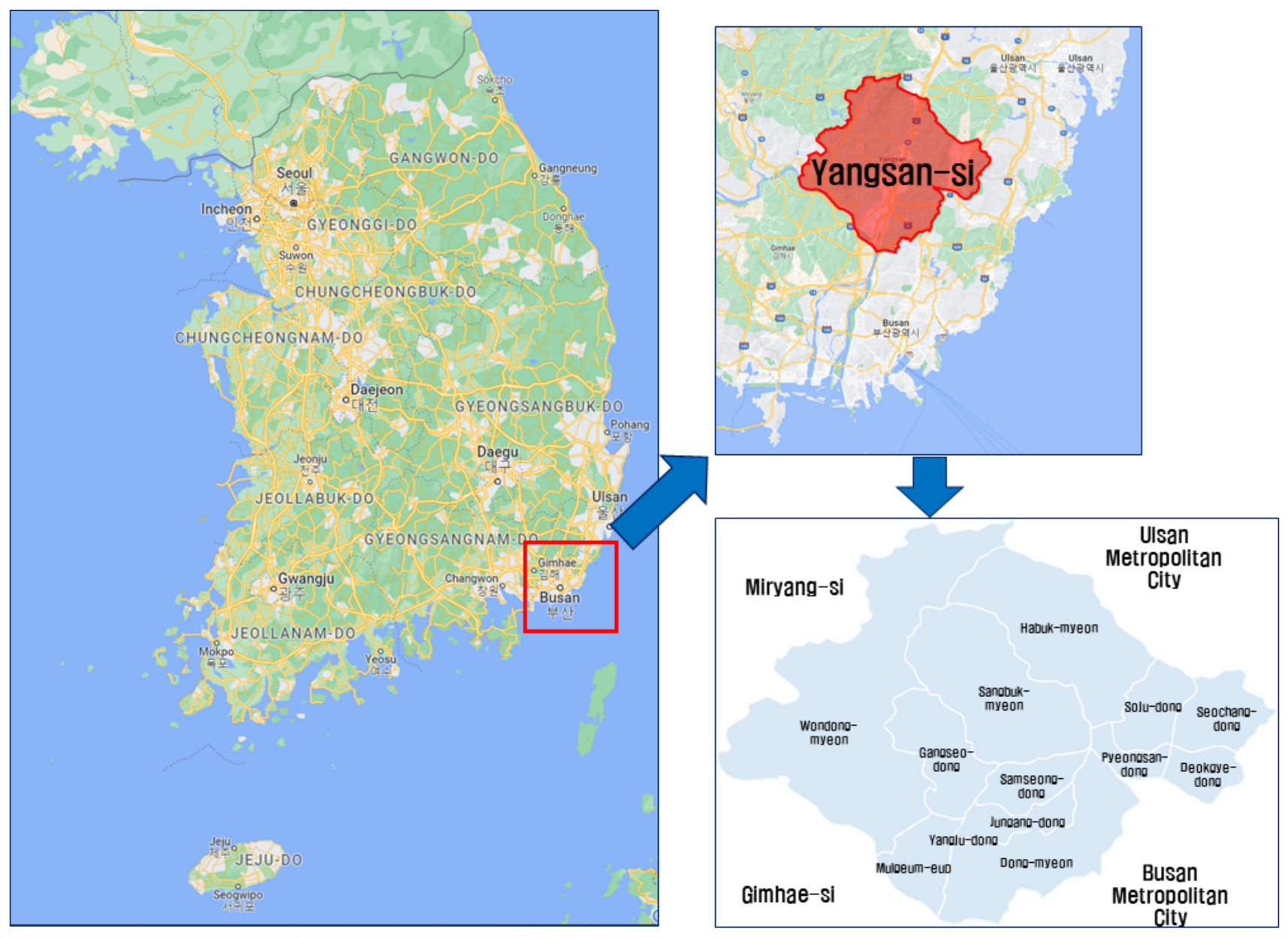


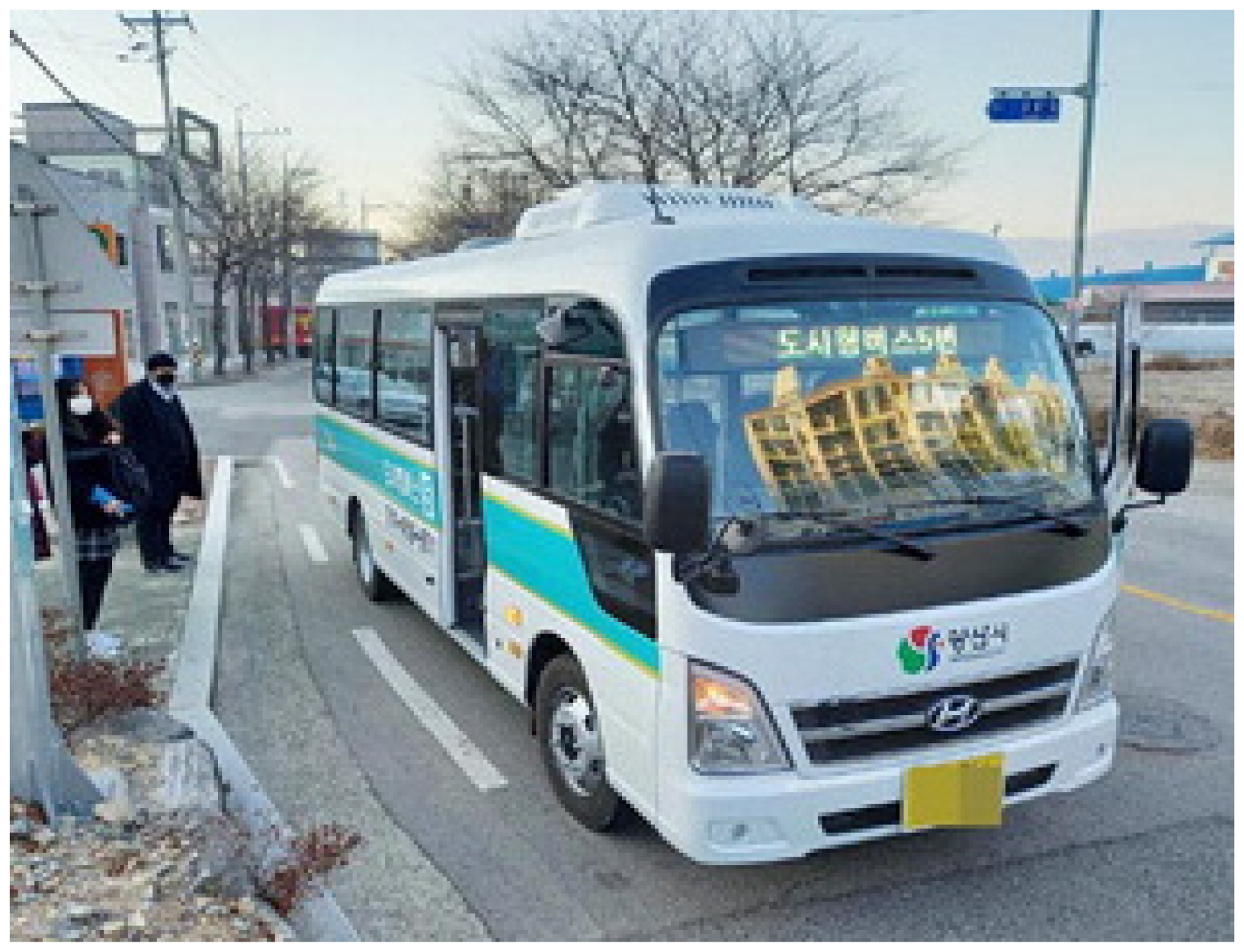
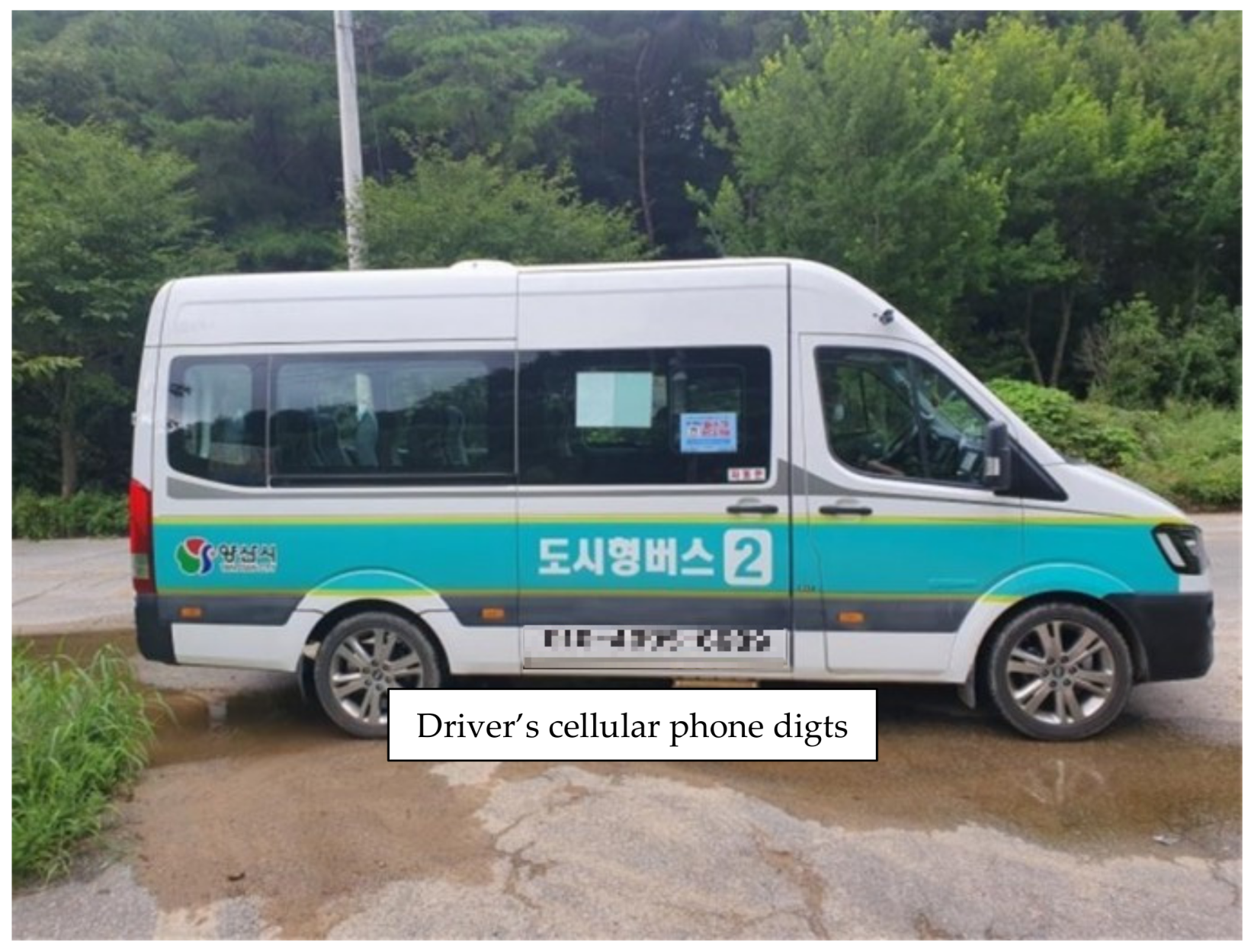
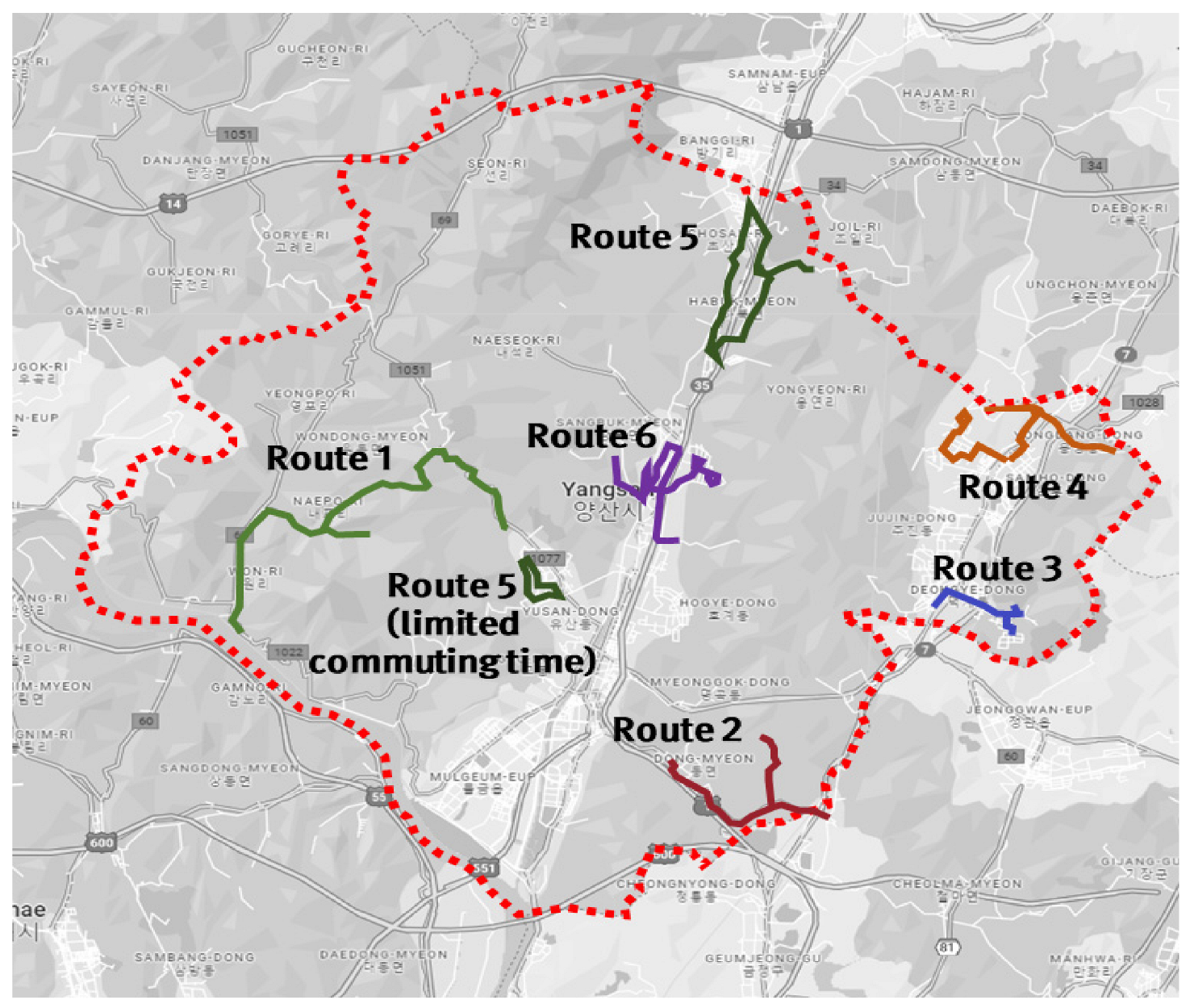
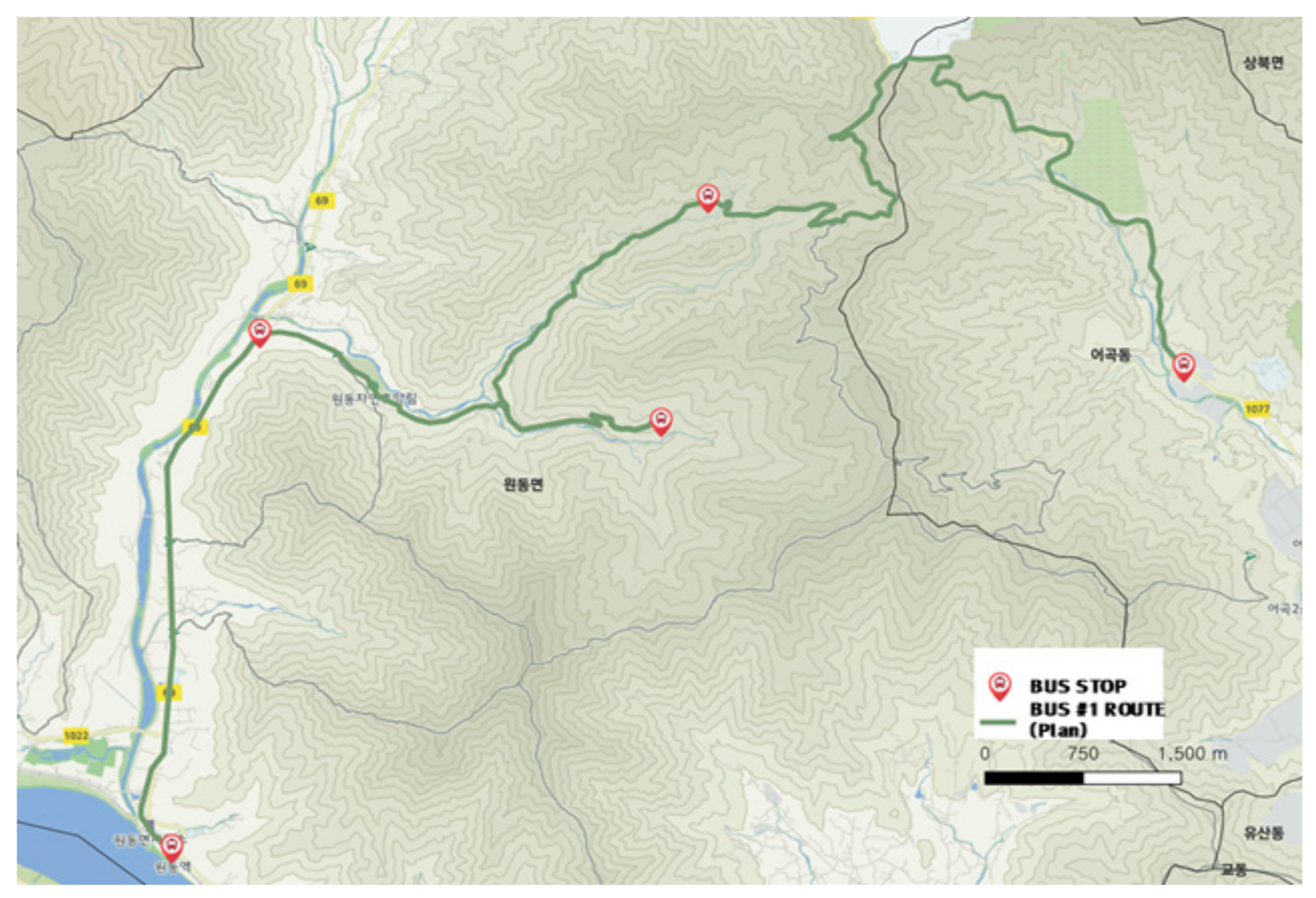
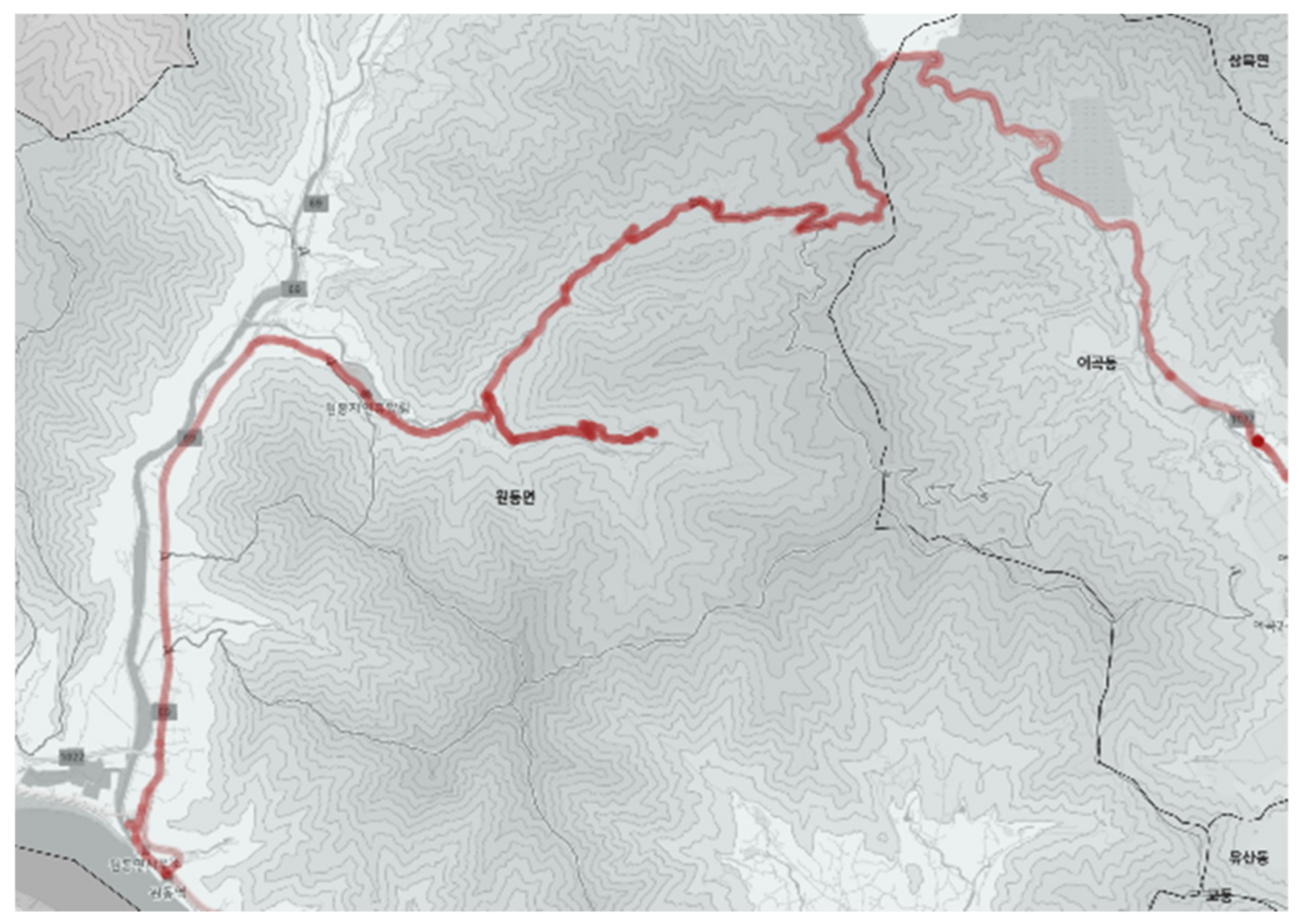


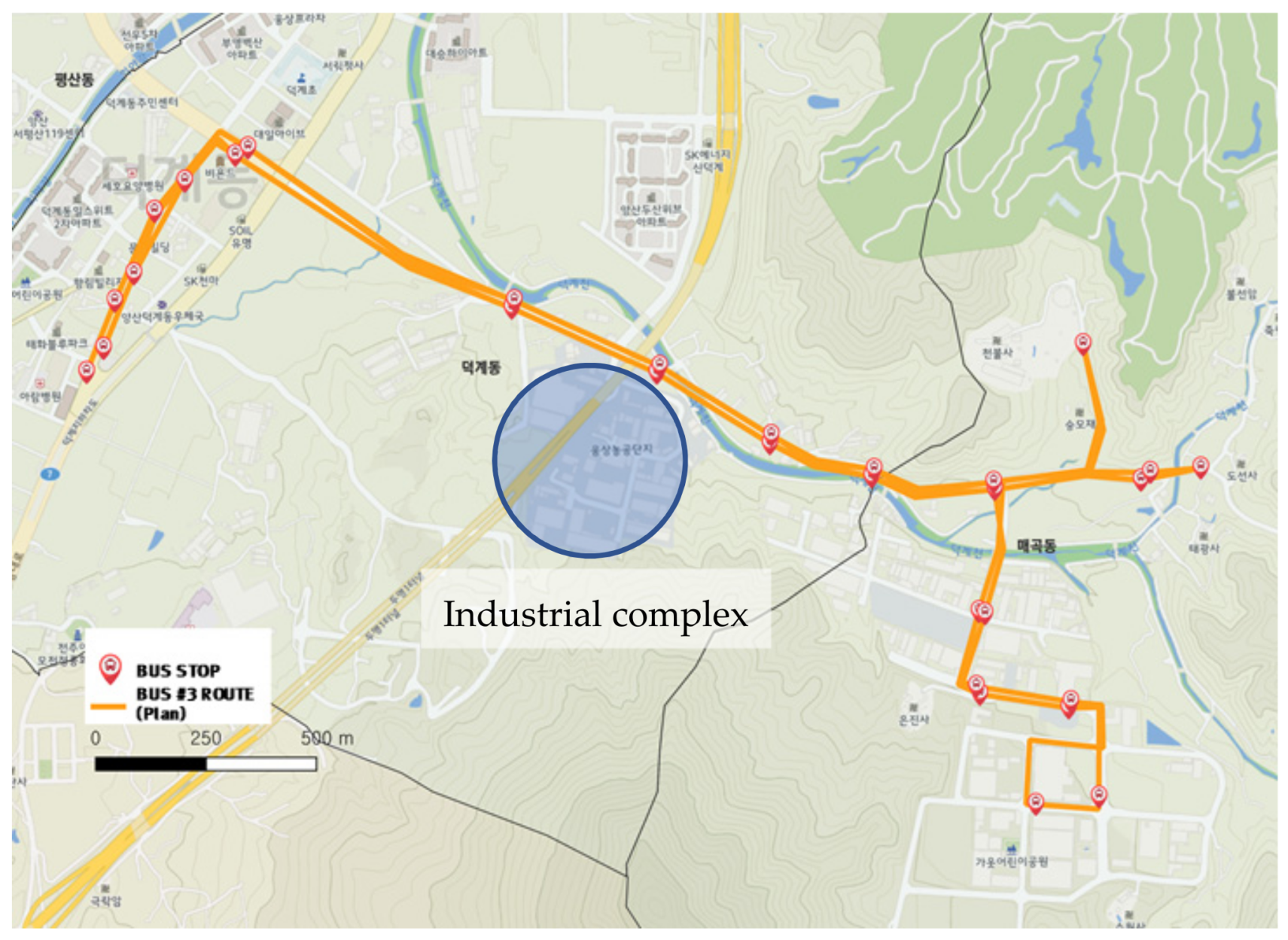
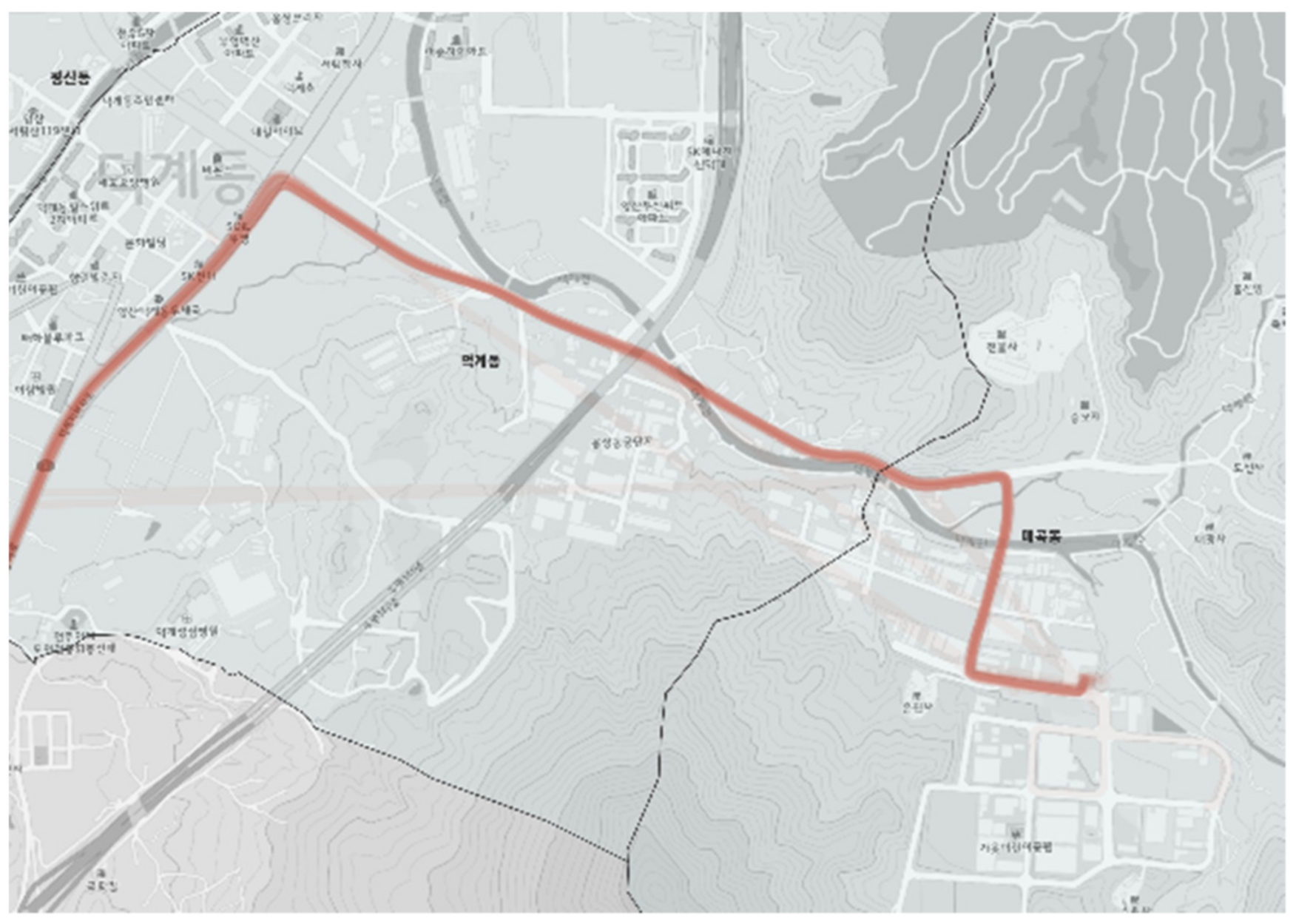
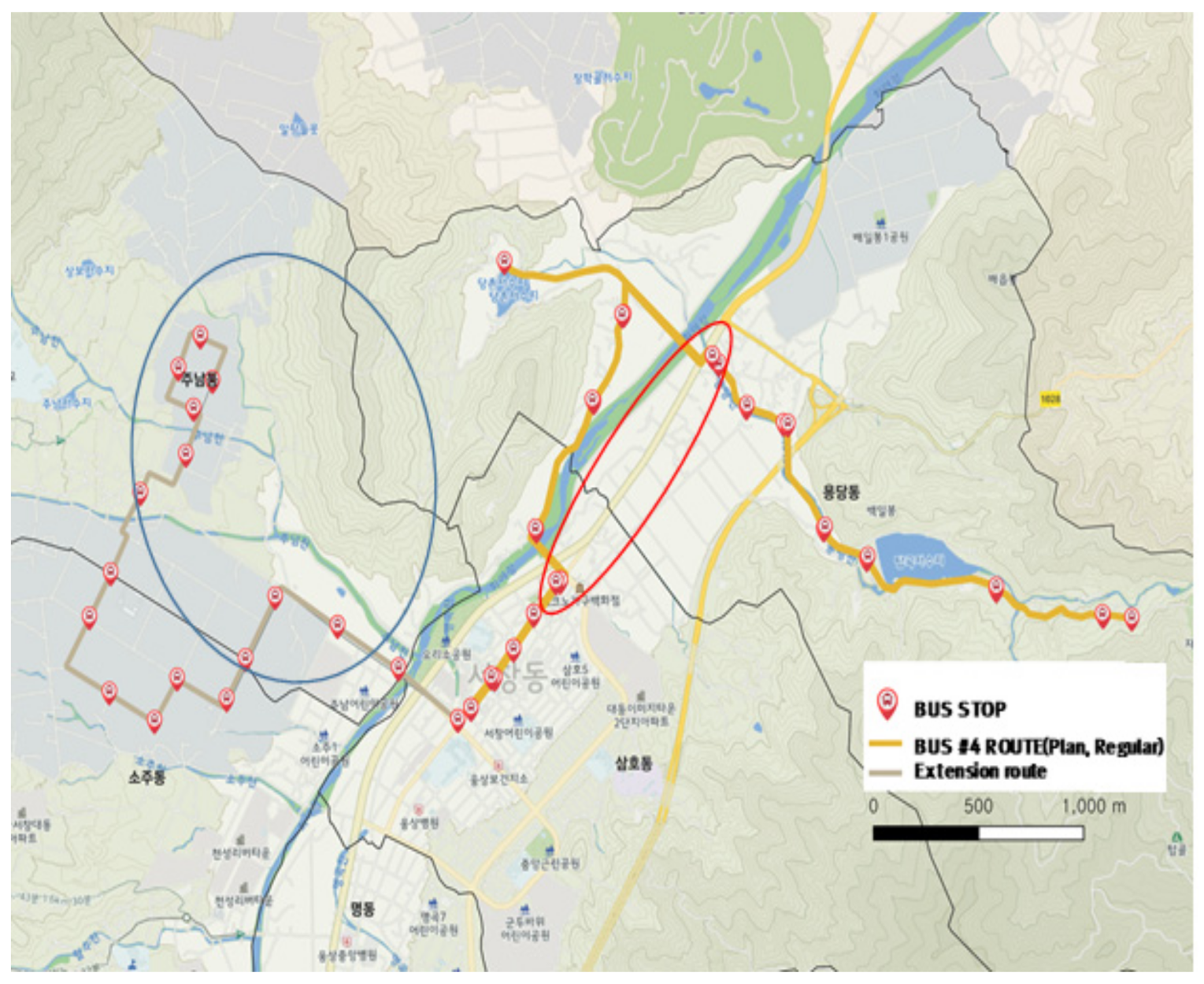
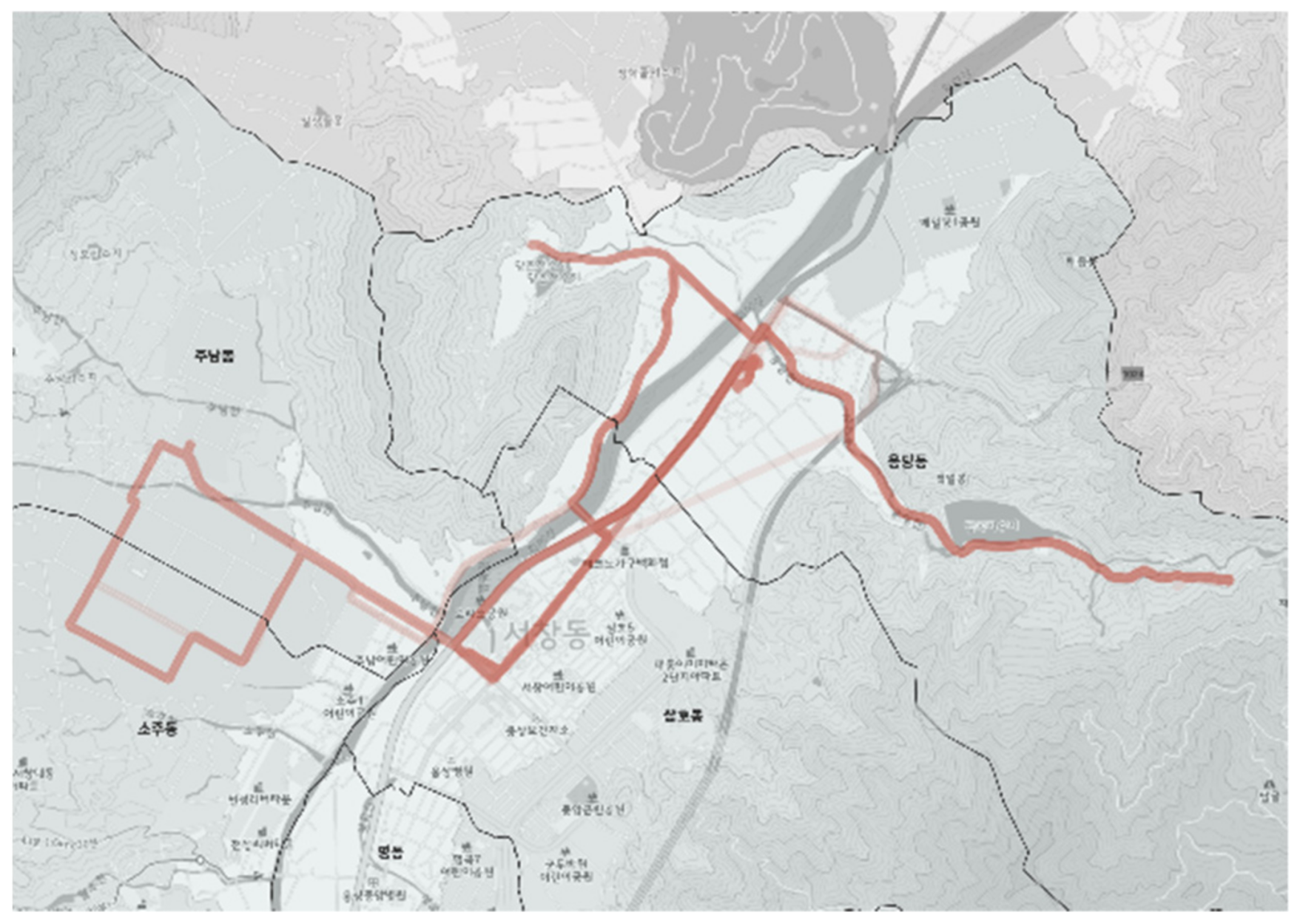
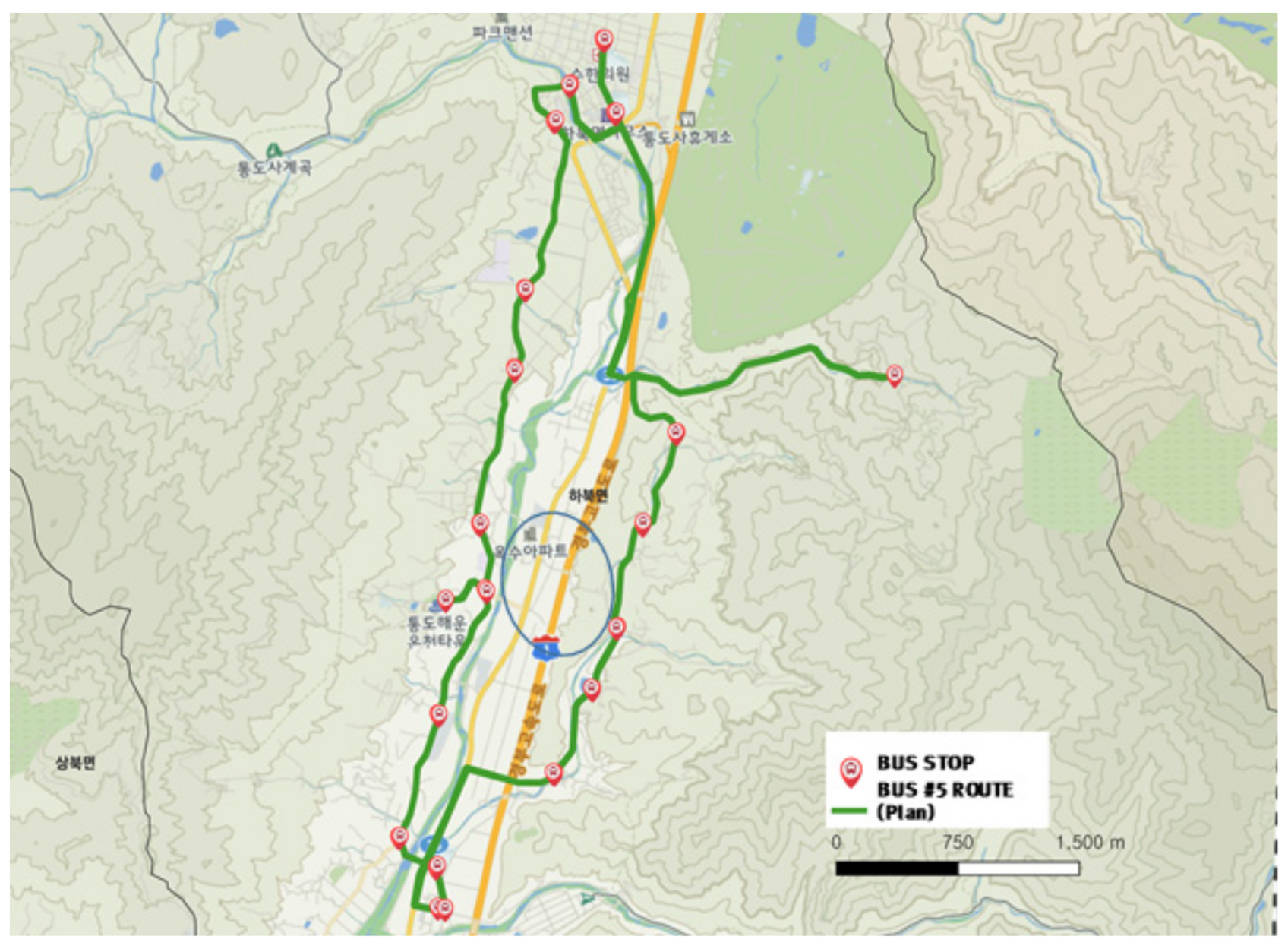
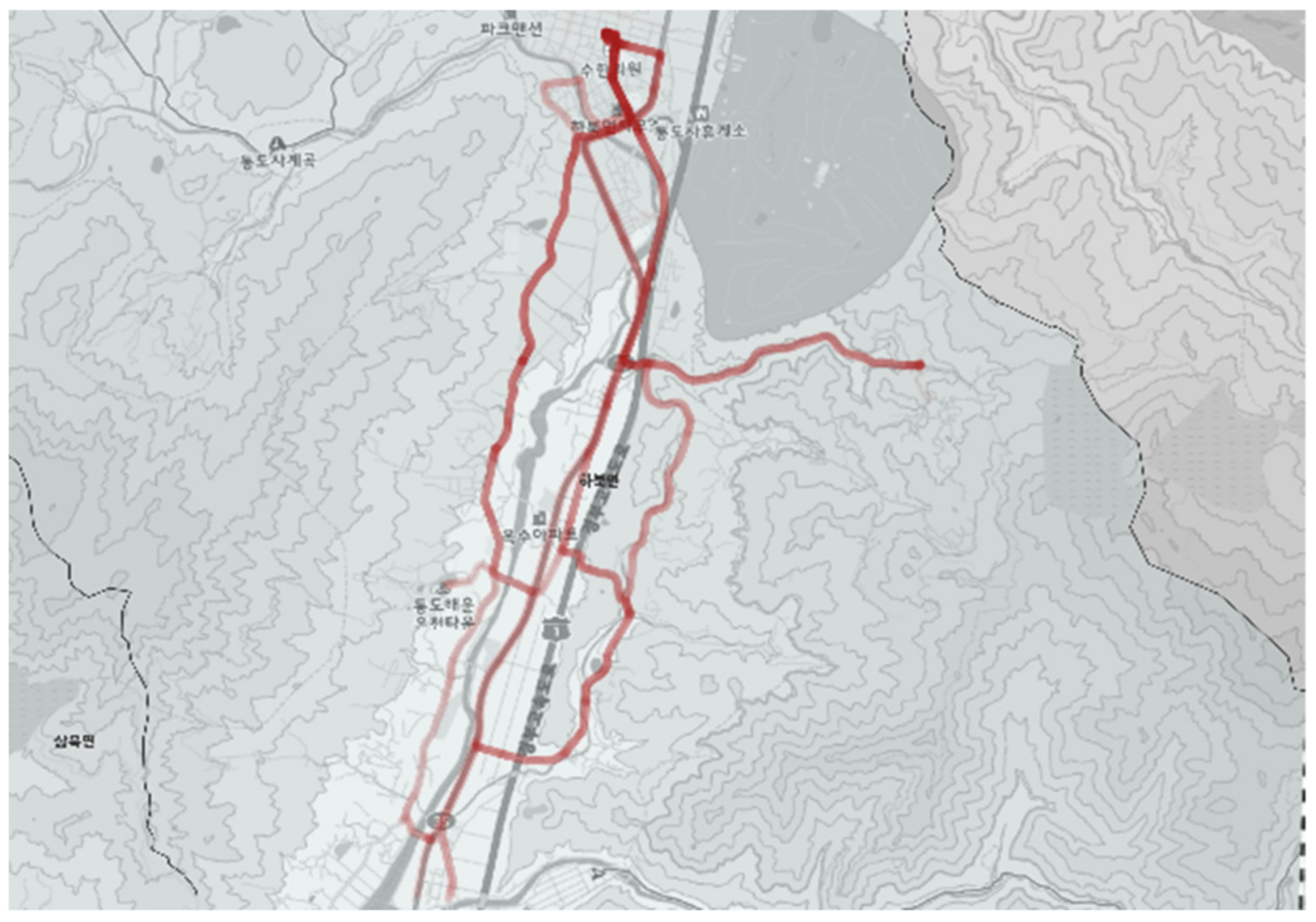
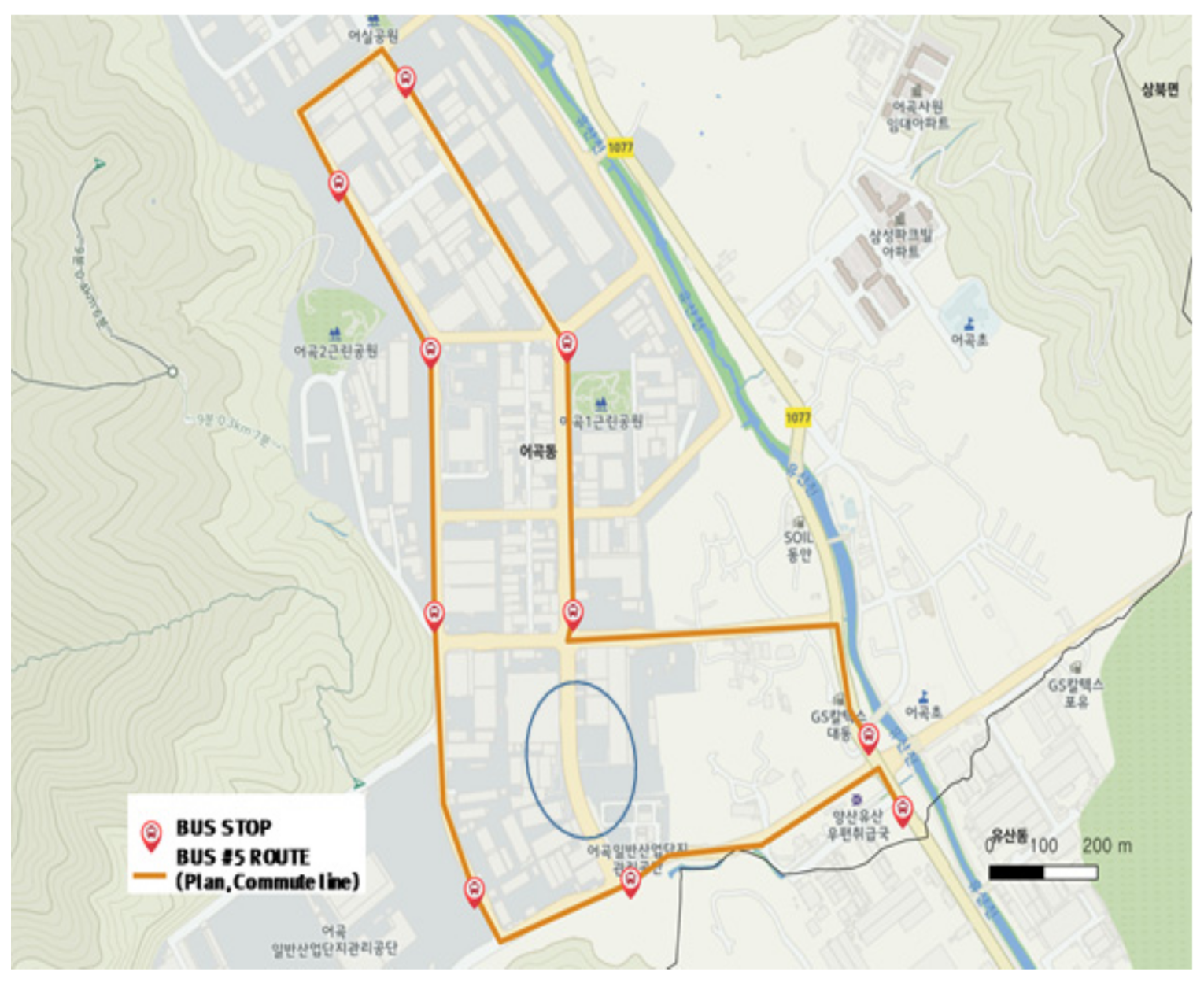




| Route No. | Operation Method | Vehicle | Characteristics |
|---|---|---|---|
| 1 | Wednesday/Sunday: not in service; Lunar new year and Chuseok long holiday: not in service; lunchtime (12:00–13:00: not in service) | Seating capacity of 11 passengers | All-day on-demand method |
| 2 | Wednesday/Sunday: not in service; Lunar new year and Chuseok long holiday: not in service; lunchtime (12:00–13:00: not in service) (serviced twice per day) | Seating capacity of 15 passengers | Regular route full-time operation |
| 3 | Oesan and Maegok are fixed among the daytime routes (serviced eight times per day) | Seating capacity of 24 passengers | Some sections are DRT |
| 4 | Yongdang and Dangchon are fixed among the daytime routes (serviced seven times per day) | Seating capacity of 24 passengers | Some sections are DRT |
| 5 | None in service if no booking; lunchtime (11:40–12:40: not in service, no booking is made) (serviced eight times per day) | Seating capacity of 24 passengers | Not in service if no demand |
| 6 | None in service if no booking; lunchtime (11:40–12:40: not in service, no booking is made) (serviced seven times per day) | Seating capacity of 24 passengers | Not in service if no demand |
| Reference Year and Month | City-Type 1 | City-Type 2 | City-Type 3 | City-Type 4 | City-Type 5 | City-Type 6 | ||||||
|---|---|---|---|---|---|---|---|---|---|---|---|---|
| Service Frequency | No. of Passengers | Service Frequency | No. of Passengers | Service Frequency | No. of Passengers | Service Frequency | No. of Passengers | Service Frequency | No. of Passengers | Service Frequency | No. of Passengers | |
| December 2020 | 107 | 60 | 80 | 185 | 71 | 95 | 38 | 37 | ||||
| January 2021 | 87 | 36 | 83 | 167 | 203 | 331 | 95 | 67 | ||||
| February | 70 | 29 | 58 | 139 | 200 | 361 | 92 | 91 | ||||
| March | 129 | 75 | 85 | 288 | 244 | 476 | 118 | 100 | 545 | 2490 | 229 | 373 |
| April | 146 | 117 | 81 | 316 | 239 | 482 | 125 | 122 | 674 | 3522 | 298 | 481 |
| May | 158 | 111 | 79 | 282 | 234 | 532 | 141 | 176 | 671 | 3314 | 293 | 450 |
| Jun. | 136 | 72 | 85 | 265 | 237 | 526 | 170 | 216 | 652 | 2938 | 298 | 532 |
| July | 140 | 90 | 77 | 232 | 239 | 537 | 176 | 184 | 642 | 2919 | 302 | 609 |
| August | 113 | 48 | 73 | 204 | 220 | 433 | 179 | 193 | 642 | 2505 | 294 | 542 |
| September | 98 | 43 | 78 | 220 | 225 | 515 | 168 | 205 | 637 | 2969 | 286 | 687 |
| Collection Information | Collection Unit |
|---|---|
| Model name | Product serial No. |
| Vehicle No. | (New)00GA0000/(Old)Seoul00GA0000 |
| Vehicle identification No. | KL000000000000000 (17 digits) |
| Vehicle registration No. | Vehicle registration No. (12 digits) |
| Transport business registration No. | 1234567890 (10 digits) |
| Driver license No. | 1234567890 |
| Driver employee No. | 1234567 |
| Driver name | ABC (initial in English) |
| Vehicle type | Intra-city bus (11)/Rural and fishing village bus (12)/Town bus (13)/Intercity bus (14)/Express bus (15)/Charted bus (16)/Special passenger bus (17)/General taxi (21)/Privately owned taxi (22)/General cargo (31)/Individual cargo (32)/Non-business purpose (41) |
| Daily mileage | km/day (Distance per day from 00:00 to 24:00, Range: 0000–9999) |
| Cumulative mileage | km (Cumulative distance from the first vehicle registration date, Range: 000000–999999) |
| Information generation time | YYYYMMDDhhmmsss (Year·Month·Day·hour·min·0.01 s) |
| Vehicle driving speed | km/h (Range: 000–255) |
| RPM (revolution per min) | Times/min |
| Brake signal | 1 (on)/0 (off) |
| Vehicle location information | GPS X and Y coordinates (indicated by a decimal number, e.g., 127.123456 * 1,000,000 = 127123456) |
| Azimuth | Vehicle’s GPS azimuth (0–360) |
| Acceleration | m/s2 |
| No. of sudden acceleration | Times (set the reference acceleration (km/h) and count the number of times above the reference acceleration) |
| No. of sudden breaking | Times (set the reference braking (km/h) and count the number of times above the reference braking) |
| No. of speeding | Times (set the reference speed (km/h) and count the number of times above the reference speed) |
| No. of events | Times |
| Fuel amount | L |
| Travel path | The path is indicated on a map |
| Equipment status | Tachograph normal (00)/Location tracking device GPS receiver abnormal (11)/Speed sensor abnormal (12)/RPM sensor abnormal (13)/Brake signal detection sensor abnormal (14)/Sensor input device abnormal (21)/Sensor output device abnormal (22)/Data output device abnormal (31)/Communication device abnormal (32)/Mileage calculation abnormal (41)/Power supply abnormal (99) |
| Example of DTG Data |
|---|
| 21092500000100|DT- 202,5.07.02|KMJTA18FPEC018515|11|6088102363|0000001|85|693058|6|602|0|128607091|35256553|34|70.0|70.9| 00|4812112900|21092509384500 221092500000100|DT- 202,5.07.02|KMJTA18FPEC018515|11|6088102363|0000001|85|693058|9|893|0|128607098|35256566|37|70.0|70.9| 00|4812112900|21092509384600 221092500000100|DT- 202,5.07.02|KMJTA18FPEC018515|11|6088102363|0000001|85|693058|12|1123|0|128607115|35256583|30|70.0|70.9| 00|4812112900|21092509384700 221092500000100|DT- 202,5.07.02|KMJTA18FPEC018515|11|6088102363|0000001|85|693058|14|1297|0|128607135|35256606|33|70.0|70.9| 00|4812112900|21092509384800 |
Publisher’s Note: MDPI stays neutral with regard to jurisdictional claims in published maps and institutional affiliations. |
© 2022 by the authors. Licensee MDPI, Basel, Switzerland. This article is an open access article distributed under the terms and conditions of the Creative Commons Attribution (CC BY) license (https://creativecommons.org/licenses/by/4.0/).
Share and Cite
Roh, C.-G.; Kim, J. What Are More Efficient Transportation Services in a Rural Area? A Case Study in Yangsan City, South Korea. Int. J. Environ. Res. Public Health 2022, 19, 11263. https://doi.org/10.3390/ijerph191811263
Roh C-G, Kim J. What Are More Efficient Transportation Services in a Rural Area? A Case Study in Yangsan City, South Korea. International Journal of Environmental Research and Public Health. 2022; 19(18):11263. https://doi.org/10.3390/ijerph191811263
Chicago/Turabian StyleRoh, Chang-Gyun, and Jiyoon Kim. 2022. "What Are More Efficient Transportation Services in a Rural Area? A Case Study in Yangsan City, South Korea" International Journal of Environmental Research and Public Health 19, no. 18: 11263. https://doi.org/10.3390/ijerph191811263
APA StyleRoh, C.-G., & Kim, J. (2022). What Are More Efficient Transportation Services in a Rural Area? A Case Study in Yangsan City, South Korea. International Journal of Environmental Research and Public Health, 19(18), 11263. https://doi.org/10.3390/ijerph191811263







